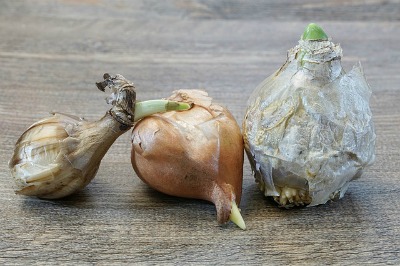Vegetative propagation or asexual propagation is the method of reproducing plants with the use of organs other than the seed and spore.
In contrast to sexual propagation, the union of the male and female sexual gametes (fertilization) is not a requisite to the production of new plants.
Hence the word “asexual”, means “without sex” or “not sexual”.

The word “vegetative” refers to plant organs with the exception of the reproductive parts.
In conventional propagation without the employment of tissue culture techniques, asexual propagation is accomplished with the use of roots, stems, and leaves.
They consist of the body or somatic cells which are formed through mitosis, the type of cell division that produces daughter cells with identical chromosomes to the parent cell.
Consequently, the new plants develop directly from any of these parts without undergoing fertilization or union of male and female gametes.
Other naturally formed plant organs which are considered vegetatively produced are likewise used.
Vegetative propagation allows the production of clones or plants which are considered “duplicates” of the parent plants genotypically, and desirably also phenotypically.
It is also convenient where a plant does not produce seeds, the seeds are sterile, or whenever seeds are not available.
Through marcotting, budding, and grafting, new plants can be produced which are readily mature or with shortened maturity.
Natural vs. Artificial Methods of Vegetative Propagation
There are two methods of propagating plants vegetatively: natural and artificial.
The natural method of vegetative propagation utilizes plant organs other than the seed and spore which, even without the involvement of man, serve as plants’ means of perpetuating their species.
These plant organs include bulbs and bulblets, cloves, corms and cormels, tubers and tubercles, tuberous roots, rhizomes, runners, stolons, slips, suckers, crowns, and plantlets.
These plant organs can be used deliberately as they are, without significant changes, in plant propagation as planting materials or propagules.
To use them, they are separated from the parent plant in which case the propagation method is also called division or separation.
In contrast, the artificial method of vegetative propagation involves the drastic manipulation of plant parts.
Without man’s active participation, they would not give rise naturally to new plants.
This method includes the use of root, stem, and leaf cuttings, layering (including marcotting), and the application of special techniques such as budding and grafting mainly to produce desirable clones with seed-grown rootstocks.
The use of vegetative parts in plant propagation has its basis in the concept of totipotency which means that cells are capable of regeneration and developing into entire plants.
Natural Vegetative Propagules and Crop Examples
Bulb and bulblet – onion (Allium cepa) and other members of the Lily family, tulip (Tulipa spp.)
Clove – garlic (Allium sativum)
Corm and cormel – Canna spp., gabi or taro (Colocasia esculentum), elephant’s ear (Alocasia macorrhiza), gladiolus (Gladiolus sp.), tannia (Xanthosoma sagitifolium)
Plantlet or keiki – Anthurium spp., Phalaenopsis orchid, spider plant (Chlorophytum capense)
Rhizome – bamboo, begonia (Begonia spp.), calla lily (Zantedeschia sp), ginger (Zingiber officinale), turmeric (Curcuma longa)
Runner – spider plant (Chlorophytum capense), strawberry (Fragaria x ananassa)
Slip – pineapple (Ananas comosus) and other members of the Bromyliad family
Sucker – abaca (Musa textile), banana (Musa spp.), pineapple and other bromyliads
Stolon – bermuda grass (Cynodon dactylon), mint (Mentha spp.), Stachys spp., strawberry geranium (Saxifraga stolonifera), zoysia grass (Zoysia spp.)
Tuber and Tubercle – Potato (Solanum tuberosum), Caladium spp., Calathea spp., Helianthus spp., yams (Dioscorea spp.)
Tuberous root – arrowroot (Maranta arundinacea), cassava (Manihot esculenta), sweet potato (Ipomea batatas), yam bean (Pacchirhizus erosus).
(Click here to read how the Starchy Root Crops, Tuber Crops, and Corm Crops are distinguished)
REFERENCES
HARTMANN HT, KESTER DE. 1975. Plant Propagation: Principles and Practices. New Jersey: Prentice-Hall Inc. p. 469-474.
KAWAKAMI K. 1978. Physiology of yield of underground storage organs. In: Gupta US, ed. Crop Physiology. New Delhi, India: Oxford & IBH Pub. Co. p. 269-309.
